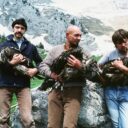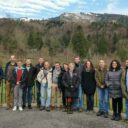
On the 25th of May a bearded vulture nestling from a wild nest in Aude in the French eastern pre-Pyrenees, later named Flamadel, had to be removed from its nest because it had been noted it was severely limping from his left leg.
The Aude bearded vulture breeding pair is included in the monitoring program of the LIFE GYPCONNECT project. Last year the nestling of this pair, Roc Gènese, was tagged with a GPS-GSM tag, the first-ever wild bearded vulture nestling ever tagged in the French pre-Pyrenees. Roc Gènese came back to its natal area after months of wandering across the Central Pyrenees (see https://www.4vultures.org/2017/05/06/bearded-vulture-roc-gen%C3%A8se-came-back-to-its-natal-area-in-the-pre-pyrenees-his-brother-flamadel-could-not-be-tagged/)
The plan was to tag again the young from the same pair this year, and thus a similar operation was mounted. Unfortunately, when the researchers arrived at the nest (24th of April) they saw that Flamadel was still too young to be tagged or ringed, prioritizing the safety of the bird over any data. Nevertheless, the close monitoring of the pair was continued. Three weeks later it could be observed that the chick was limping severely, and after no improvement during the following days, it was decided to remove Flamadel from its nest and transfer it to the recovery center from LPO Hérault.
There, and suddenly, the chick stopped to eat, losing weight in the following days, being necessary to take an urgent decision. Knowing that chicks still require social contact for their welfare and growth, it was decided to transfer it to the recovery center Vallcalent in Catalonia (Spain), one of the three large specialized Bearded vulture captive breeding centers included in the EEP, where additionally there is a specialized vet on this species.
On the 2nd of June, one day after his arrival at Vallcalent, the X-Rays confirmed that the bird had suffered a distal fracture on the left tibia, between diaphysis and epiphyses, which was fully welded but inclined inwards. The first objective was to assure the survival of the bird and it was decided to realize a conservative therapy bandaging the leg with a splint, trying to relocate it in an anatomical position and to stretch the articulation, and to postpone the surgery to a later stage when the bird was adapted completely in its new conditions.
During the following months the bandage had to be changed twice a week, using different types of splints and finally adapting a cane for fixing the leg. Further, Flamadel was transferred into an aviary where a breeding pair was raising his own chick. Soon later Flamadel started to eat and to win weight and finally Flamadel was adopted by the female when her own chick was removed.
Finally, on the 18th of September surgery was done on Flamadel, because the leg without bandage remained stretched in front of his body, hindering the displacement. It was decided to realize a double fracture to try to relocate the leg. It was fractured in the middle tibia – turning towards the outside distal part of the tibia- and the tarsus, turning inwards the distal part of the tarsus. Flamadel has supported perfectly the surgery and is eating without problems, hoping that in a few weeks the fixing nails can be removed and the leg can be better used.
The whole process has been done under the supervision of the veterinary Olga Nicolas from Forestal Catalana, and staff from the VCF. The VCF would like to thank the Catalonia Government.
The LIFE GYPCONNECT is part of the VCF strategy to restore the species in western Europe, promoting movements of the species between Iberia and the Alps, which will also help increasing the genetic diversity of both populations, and accelerate the end of the reintroduction project in the Alps.
Photos: VCF, Generalitat de Catalunya (X-Ray), LPO Hérault (X-Ray)





